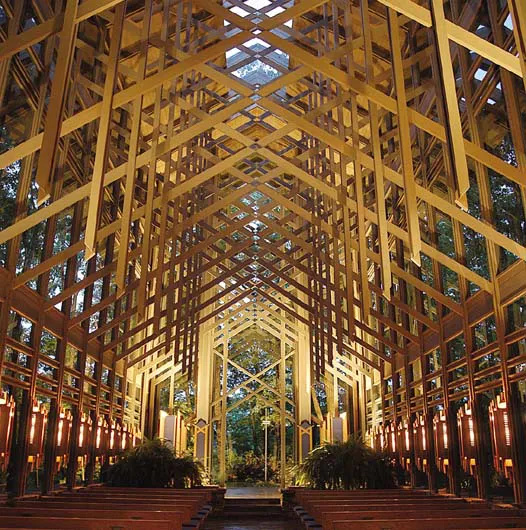![]()
| Part 1 | Load-bearing
construction |
![]()
Monolithic bearing walls – masonry, stone, concrete
Masonry is the collective term used to describe wall construction using brick, stone, concrete block, or other stacked modular elements. Each component part is set upon another. Using the weight of modular elements to counteract external loads the construction is structurally efficient in compression but poorer at resisting perpendicular tension forces. For the purposes of discussion we will consider bearing wall construction assembled from many small pieces, like brick or stone masonry, to be monolithic, like poured concrete walls, since the structural behavior is essentially similar to that of a single cantilevered plane, conceptually.
Masonry is one of the most ancient and durable construction methods and requires intensive hand labor. Each worker can, however, lay the constituent elements if size and weight permit; therefore it is an economical construction system. Rich and varied effects can be produced from many small pieces, for constructive as well as decorative effect. Stacking of similar elements is the simplest and most ancient of building techniques, and is still widely used around the world. Historical examples and monuments can be found across all cultures with access to stone and brick manufacture. These buildings and structures made of highly durable materials have survived the centuries and show evidence of increasing sophistication and technological innovation in each culture, as the builders explored new methods of achieving structures for cultural, political, and religious glory.
Historical survey
Ancient monuments such as the Great Pyramid at Giza, Egypt, 3000 BC (Figure 1.1), were built with long-lasting masonry to protect the bodies of the ancient rulers after death for return of the soul. These tombs brought glorification to the Egyptian Pharaohs by virtue of the sheer scale and size of the pyramids, made all the more impressive by the limited tools and materials available at the time. There are many theories regarding how the material for the pyramids was transported from faraway quarries and erected. What remains exposed to view today is largely the interior granite structure. Limestone facing panels were originally attached, likely with dowels, to the rough limestone backup blocks largely remaining today, dressed to a smoother, finer finish.
◀ Figure 1.1
Pyramids at Giza
The Great Wall of China, 210 BCE (Figure 1.2), is another example from a different culture where small elements were assembled into a monumentally scaled structure. Rammed earth with masonry rubble infill was used to give internal structure to the fortification (see Figure 1.3). Faced with more durable stone masonry during the Ming dynasty and extended, the wall was used to protect the Chinese against incursions by hostile forces. Besides military control of the border, the wall functioned to provide a continuous path of access for the troops. It also created a physical barrier for trade and an opportunity to control taxation, and became a symbol of unity and vast control, throughout its length.
▲ Figure 1.2
Great Wall of China
The ancient Greeks and Romans used stone and masonry in the construction of monuments, temples, and lesser structures, as well. The permanence of these structures, from the Parthenon from 447 BC through examples of Roman temples and ruins in cities across the Empire surviving today, is a testament to the durability of the simple stacked masonry technique. Roman masonry construction produced excellent examples of brick use at Ostia, a port town near Rome, in the first to second century AD. Brick-faced concrete warehouses, shops, and residences were constructed in this region where the soil was rich in terracotta/brick slay and silt, sand, and gravels (see Figure 1.4). There were no good local marble quarries, only soft tufa and travertine stones, so masonry brick made from locally available materials was assembled using mud between joints as mortar, initially. Limestone was ground into lime powder and used to form an early lime-based mortar. Roman brick was fabricated in squares, cut on both diagonals into right triangles, and then embedded with this improved surface
◀ Figure 1.3
Great Wall of China – restoration view
▶ Figure 1.4
Roman brick – Ostia
◀ Figure 1.5
Roman brick – construction of walls, arches, vaults, and domes
exposure to rubble fill. As shown in Figure 1.5, this produced a composite brick-faced concrete wall with the more durable brick used only at the surfaces exposed to wear. In some types of brick construction, a leveling course was used to bond the brick and concrete sandwich, a precursor to modern ties. A variety of face-brick insertions into the rubble masonry can be identified, from the more regularized, rectangular shapes of Opus Reticulatum (see Figure 1.6), through rougher irregular-faced masonry, such as Opus Incertum.
▶ Figure 1.6
Opus Reticulatum
The ancient Greeks and Romans had discovered that volcanic pumices and tufa stone, most famously the ones found in Pozzuoli, Naples, and thus pozzollan, could be crushed and ground. When mixed with limestone and burned, the result could be used to produce a harder, stronger, and more adhesive material than lime mortar alone. This material was used as a binder for masonry as well as in the mixture for concrete, or Opus Caementicium (see Figure 1.5). The use of this Roman invention dated to the first century, and it could be poured into forms with permanent masonry components or against removable wood formwork.
The Roman Coliseum, 80 AD, synthesized these structural achievements in one example where brick-faced concrete m...







